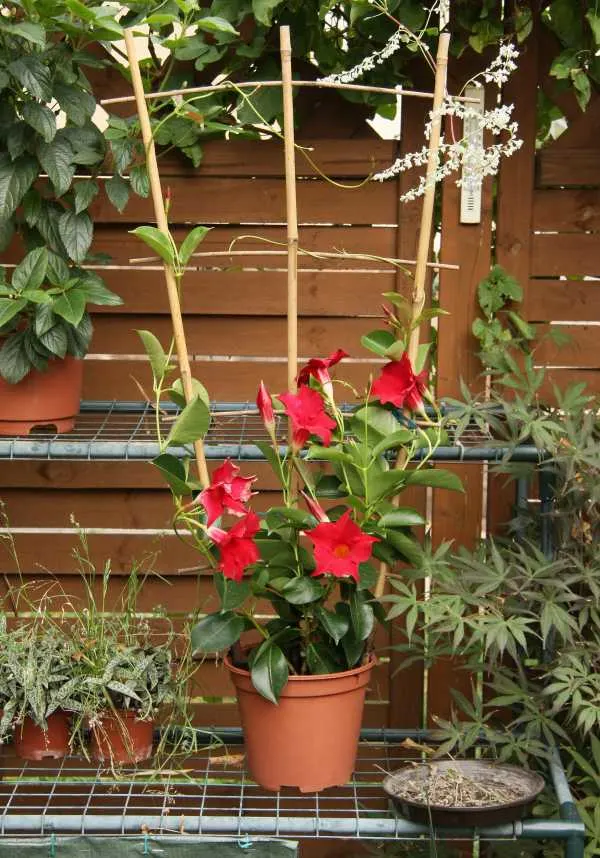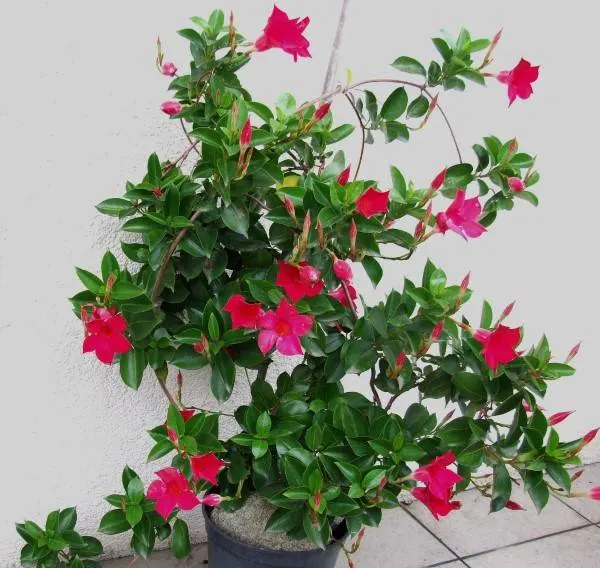Mandevilla, also known as rock trumpet, is a tropical flowering vine native to Mexico, Central America, South America, and West Indies. With its bright red flowers, the plant provides a treat to the eyes.
If you are reading this article, chances are you already own a rock trumpet plant. You cherish and wish to learn how to propagate Mandevilla plant to expand the beauty the plant has to offer.
Propagating a plant can be challenging and you have come to the right place to learn how to propagate Mandevilla plant via two easy methods. Just follow this guide to learn.
- What Is Plant Propagation?
- Propagation Techniques for The Mandevilla Plant
- What is the Perfect Season to Propagate the Mandevilla Plant?
- Things You Need
- Method 1: Using Seeds to Propagate a Mandevilla Plant
- Method 2: Propagating a Mandevilla Plant Using Stem Cuttings
- Aftercare Of A Propagated Mandevilla Plant
- Evaluating The Two Propagation Methods
- Method 2: The Stem Cutting Method
- Conclusion
- Sources

What Is Plant Propagation?
Let’s get this fact straight, almost everyone likes plants, and why wouldn’t they? Plants are pleasant to the eyes, clean the environment and provide a pleasant hobby to humanity. With all the benefits plants have to offer, it is a no-brainer that we wish to expand and increase their footprint on Earth.
Plant propagation refers to increasing the number of plants through various techniques ranging from stem cuttings to layering. Since plants are dynamic, different plants require different propagation techniques. It cannot be very clear, especially for a beginner.
As the Mandevilla plants belong to the plant-type vines, they require special attention and care when being propagated.
Propagation Techniques for The Mandevilla Plant
Mandevilla is a delicate vine and its two most used propagation techniques are seed propagation and stem propagation. This article explains both methods in detail in a step-by-step guide so that you can learn how to propagate Mandevilla plant.
What is the Perfect Season to Propagate the Mandevilla Plant?
Plants are living beings undergo a natural growth cycle due to which plants cannot be propagated anytime we want them to be (Although it would be great if we could propagate and plant at any time of the year). Since the Mandevilla plant blooms in summer, it is best to propagate it just after the end of winter or in early spring.
Things You Need
Propagating a plant is a strategic task; hence, you need to prepare yourself to avoid undesirable events (you do not want a disaster instead of new healthy plants). Prepare the following things before hands:
- Mandevilla Seeds
- Rooting Hormone
- Pruning Shears
- Perlite
- Watering Can
- Soil Fertilizer
- BOOST PLANT GROWTH with Jessi Mae Horticultural Perlite for indoor plants. Our coarse perlite improves soil structure, enhancing aeration and drainage and giving plant roots greater nutrient access.
- 1-QUART BAG of perlite gravel for plants drainage is also ideal for use as a seed starter growing medium. It is essential to precision cactus mix or carnivorous plant soil as it pulls water away efficiently.
- WATER STORING CRYSTALS can hold up to 4X their weight in moisture and can retain vitamins and nutrients for short periods. Perlite for gardening is a must-have addition to your terrarium supplies.
- ALL-NATURAL PERLITE is pH-neutral so it will not alter the composition of your carnivorous plant soil. It also resists compaction, helping to keep soil light and making it ideal for indoor gardening.
- MADE IN THE USA from chemical-free and natural materials, Jessi Mae Organic Perlite is suitable for herb gardening, Venus Fly Trap soil, perennials, tropicals and an array of exotic indoor plants.
- Specially formulated with micronutrients to help plants grow strong and produce more fruits and vegetables versus unfed plants
- Feeds up to 3 months
- Calcium helps form stronger cell walls, producing better quality and longer-lasting fruits and vegetables. Plus, it helps prevent disorders in edible crops commonly associated with calcium deficiency
- For use in ground and in containers
- Now contains natural ingredients that helps feed and nourish above and below soil, for even better quality and longer lasting fruits and vegetables versus unfed plants
Method 1: Using Seeds to Propagate a Mandevilla Plant
It is the easiest and beginner-friendly method of propagating a Mandevilla plant. For the execution of this method, you would require fresh Mandevilla seeds; you can get some from your existing adult Mandevilla plant; alternatively, you can also ask the good neighbor next door who owns a beautiful garden.
Step 1:
Collect Mandevilla seed pods from your adult Mandevilla plant and let them dry. You can dry the pods by placing them under direct sunlight for about 3-4 days.
Step 2:
Once the pods are dried, you can extract the seeds from inside. You can extract the seeds manually; it won’t take long to do so. Just be careful and try not to damage the seed.
Step 3:
Soak the Mandevilla seeds in room temperature water for about 12 hours. You can use normal tap water for the purpose, no fancy requirement here.
Step 4:
Plow the soil where you need your new Mandevilla plant to grow. Select warm and moist areas without direct sunlight since Mandevilla plants thrive in such areas.
Step 5:
Sprinkle the Mandevilla seeds on the soil and put a thin layer of soil to cover them. Mandevilla seeds thrive in shallow planting, so do not put a thick layer of soil over the seeds.
Step 6:
Congratulations, you just learned how to propagate Mandevilla plant! Just water your seeds, and your seeds will germinate in a month.

Method 2: Propagating a Mandevilla Plant Using Stem Cuttings
It is an advanced method that requires more skills to be executed properly but not to worry, my friend! This step-by-step guide will tell you how to propagate Mandevilla Plant using stem cutting.
Step 1:
Take your adult Mandevilla plant and cut about 3-4 inches cuttings from the side shoot of your adult plant using your shears.
Step 2:
Remove all the leaves from the cuttings except the ones at the top. You can either cut the leaves using a pair of scissors or can pluck them manually.
Step 3:
Dip your cutting in hormone mixture. You can buy the mixture from your local gardener or online. It will allow your plant to grow properly.
Step 4:
Repeat the process of step 4 of the seed propagation method. Alternatively, you can also use small pots to grow a new Mandevilla plant from your plant cuttings.
Step 5:
Poke a 3–4-inch hole in the soil. Poke as many holes as your cuttings, keeping a 2-inch distance between each hole.
Step 6:
Place your cuttings into the holes, sticking 2 inches of the cuttings above the hole. Be very careful at this stage and do this step with utmost caution. The wrong placing of your stems can hinder plant growth.
Step 7:
Press the soil against the cuttings sticking in the holes. Gently but firmly press the soil to cover the surrounding of the stem.
Step 8:
Water your newly planted stems and enjoy your new Mandevilla plant grow.
Aftercare Of A Propagated Mandevilla Plant
Post propagation is a very delicate and crucial time for the plant. Since the plant is adjusting to the new environment, it is vulnerable to pests and insect attacks. Hence it would help if you were very diligent and constantly lookout for possible pests and insects. If your plant becomes infested with pests, use pesticides and insecticides to protect it.
Take care of the moisture needs of your newly propagated plant as well. Since Mandevilla plants thrive in a moist environment, mist them 2 times a day but do not overdo it, you do not want a soggy atmosphere, maintain the perfect balance.
Evaluating The Two Propagation Methods
Method 1: The Seed Method
Advantages
- Easy to execute
- Beginner-friendly
- It does not require a lot of tools
Disadvantages
- Time-consuming since plants take more time to produce seeds
Method 2: The Stem Cutting Method
Advantages
- Time-efficient
- Cost-effective, i.e., one plant can be used to propagate many plants
Disadvantages
- Requires advanced gardening skills
- Requires gardening tools
Both of the methods discussed to propagate a Mandevilla plant have their advantages and disadvantages associated with them. The best method for you is the one that caters to your needs and skill set. So before propagating a plant, evaluate your needs and requirements to avoid problems for later.
Conclusion
There is no denying the fact that Mandevilla plants are breathtaking. There is just something about the red-shaped flowers that attract one to their beauty. Considering the price hike in the plant market, propagating a plant is a smart decision both financially and strategically.
This step-by-step guide on how to propagate Mandevilla plant via 2 methods is your ultimate solution to all your Mandevilla propagation queries. So, what are you waiting for? Get your gardening hands in action and propagate some Mandevilla plants. Don’t forget to leave us a comment below!


